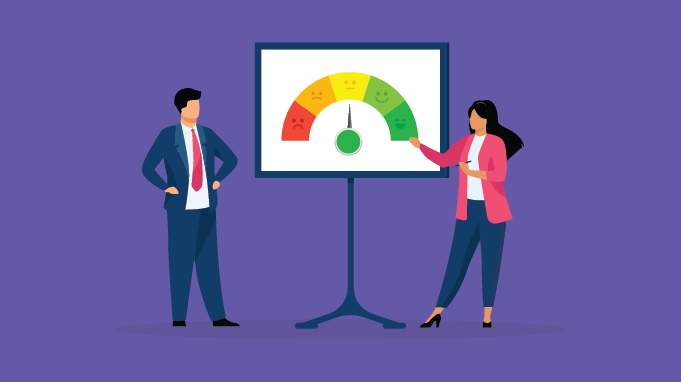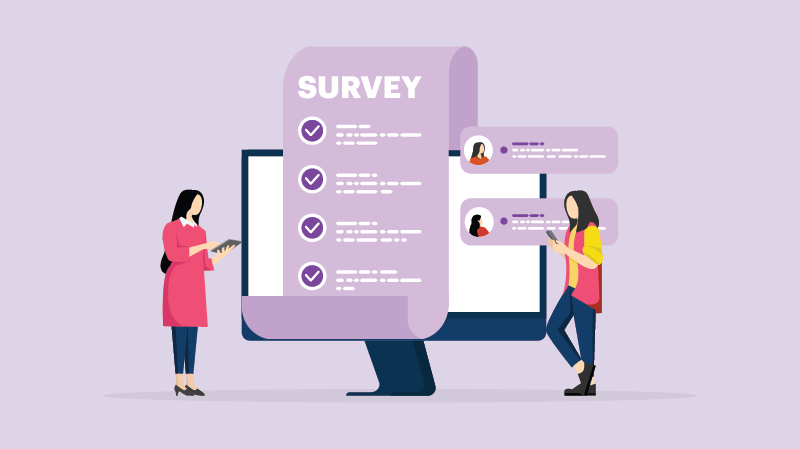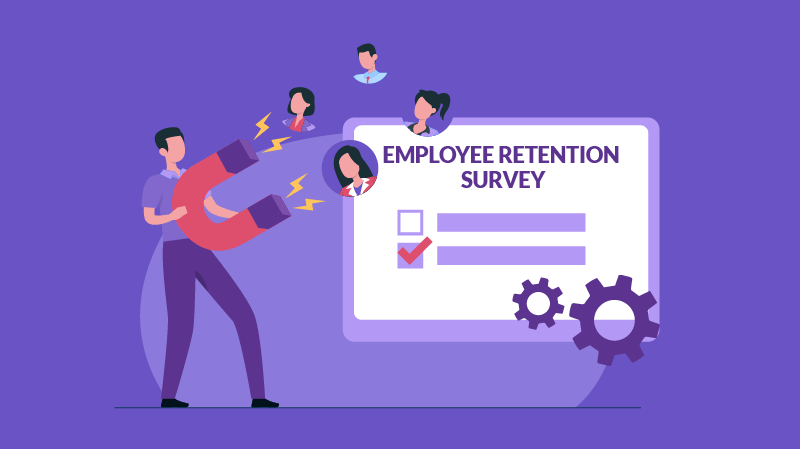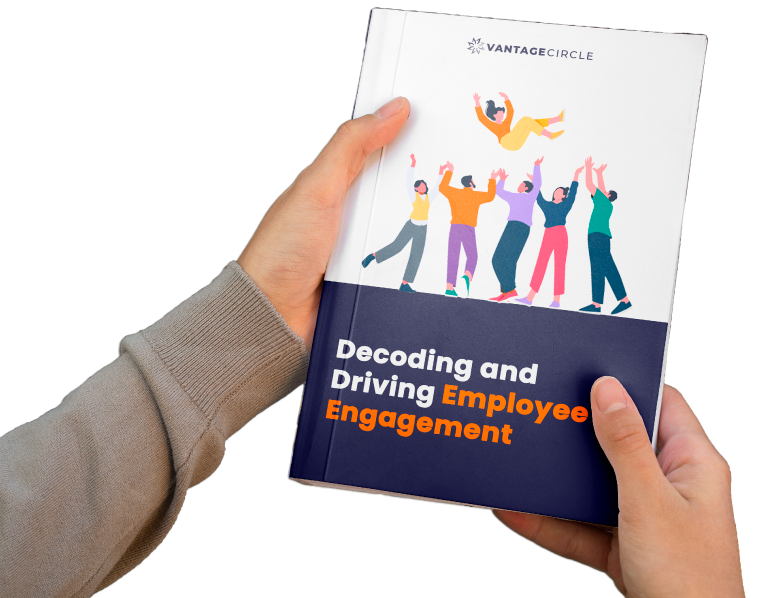How To Calculate Employee Net Promoter Score: The Ultimate Guide
Have you ever wondered how your employees feel about your organization? Are they genuinely happy and loyal?
Well, you are not alone. As more and more businesses realize the need to stay on top of employee satisfaction, that’s where the Employee Net Promoter Score (eNPS) comes in handy. eNPS is a metric that helps companies measure and improve employee experience and engagement. There's been a big surge in the adoption of eNPS in the corporate world for its efficiency in measuring employee experience by gaining insight into employees' feelings and opinions.
It has garnered praise for helping organizations track employee engagement levels, identifying problem areas, drawing comparisons of benchmark performance, making the process hassle-free, driving continuous improvement, and enhancing employee retention and loyalty.
So, let's break down eNPS in simple terms. Whether you're an HR expert or just starting out in business, this guide will give you the essential information on using eNPS to create a happier and more productive team.
What is eNPS (Employee Net Promoter Score)?
Employee Net Promoter Score is a survey-based scoring system that helps employers gauge employee satisfaction and loyalty. As an effective metric, it allows companies to assess to what extent employees are willing to recommend their organization as a suitable workplace. You can determine how impactful your existing business practices are on the satisfaction and engagement levels.
The scoring pattern ranges on a scale of 0-10, where respondents are further categorized as Promoters, Passives, and Detractors. It is derived from the Net Promoter Score system from Bain & Company, Satmetrix Systems, Inc., and Fred Reichheld, which is known for gauging customer loyalty.
The eNPS is not just about the score but about the subsequent action. Use the data to make real changes in your organization.
eNPS vs NPS
According to a study by Forbes, it is estimated that two-thirds of Fortune 500 companies use some versions of NPS. Tracking the rise and fall of this one digit can tell you so much about your customer base.
Net Promoter Score (NPS) is a metric used in customer satisfaction surveys to measure customer loyalty to the company. The idea is narrowed down to a single question “How likely are you to recommend the product/ service to a friend or colleague?” Respondents rate their inclination on a scale of 1- 10 and are further categorized into promoters, passives, and detractors.
The NPS is calculated by subtracting the percentage of Detractors from the percentage of Promoters, resulting in a score from -100 to +100.
Employee Net Promoter Score (eNPS) branched out from the NPS methodology also aims to measure the loyalty and satisfaction levels, not of the customers but the employees. Instead of asking customers about their likelihood of recommending the company, eNPS asks employees how likely they are to recommend their company as a workplace. The eNPS is calculated similarly to NPS, subtracting the percentage of Detractors from the percentage of Promoters to yield a score ranging from -100 to +100.
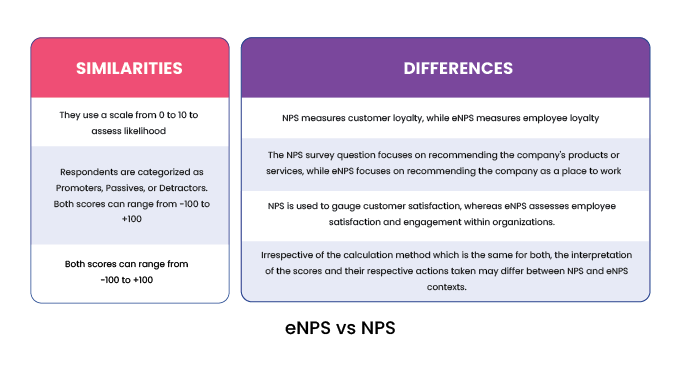
How to Calculate eNPS?
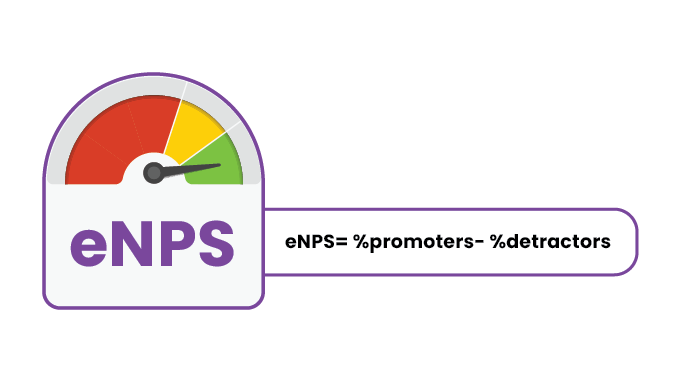
After garnering a sound understanding of eNPS, let us delve into the calculation part.
The calculation of eNPS involves categorizing employees into three groups based on their responses and applying a formula to determine the score. You have been introduced to the categories, namely promoters, passives, and detractors. First, let us understand them individually.
Promoters: The employees under this category are highly satisfied with their work and experience at the company and are drawn to recommend it to others. They are deemed enthusiastic advocates of the company.
Passives: These employees are satisfied with the experience but aren’t as enthusiastic as the promoters. They take a neutral stance where they are not emotionally invested nor disengaged.
Do not neglect the 'Passive' respondents. They may be the easiest to shift towards becoming 'Promoters.'
Detractors: These are dissatisfied employees who are unlikely to recommend their company for work. They tend to spread negative word of mouth and discourage others from joining.
On a scale of 1-10, promoters are the ones who secure 9 or 10, passives 7 or 8, and detractors 0 to 6.
However, there are instances like Vantage Pulse that follow a 0-5 rating scale catering to the ease of their workforce.
Now subtract the percentage of detractors from the percentage of promoters and derive your eNPS score.
eNPS= %promoters- %detractors
To simplify things for you, let us chart down an example.
Supposedly, you conduct a survey for 100 employees and receive the following responses:
Promoters (scored 9 or 10): 40 employees (40%)
Passives (scored 7 or 8): 30 employees (30%)
Detractors (scored 0 to 6): 30 employees (30%)
Now, to determine the score, use the formula
ENPS= 40%- 30% = 10%
Learn More: Employee Net Promoter Score (eNPS)Calculator.
Remember, the eNPS measures employee engagement and loyalty, not employee performance.
What is a Good eNPS Score?
After determining the score, you might wonder what the ideal or good score for your company would be. Well, interpreting the score and discerning its value can differ across industries. Let us explore them in the section below:
1.Technology: Good eNPS scores in the technology range from 20 to 40, with 50 above being for the top-performing companies.
-
Retail: A score above 30 is considered good for retail companies, with 50 being excellent
-
Healthcare: A good eNPS score lies between 20 and 30 for the healthcare industry, with above 40 being exceptional.
-
Financial services: A good score for the financial services industry range between 20 to 35, with 40 above being exceptional
-
Manufacturing: A score between 20 and 30 is considered good for the manufacturing industry, with scores above 40 considered excellent.
After understanding the ideal scores for respective industries, it becomes equally important to understand what they indicate. Understanding the implications can help organizations figure out areas for improvement, prioritize incentives, and create a productive work setting.
As you know, the score derived from the survey ranges from –100 to 100. So, let us go through the meaning and implications respectively.
-100 to 0: A negative eNPS score suggests that the company is dominated by detractors and fewer promoters, thereby indicating employee satisfaction and loyalty issues. This requires immediate intervention and action on your end by addressing underlying problems and improving employee experience and engagement.
0 to +30: This low to moderate score suggests that there lies room for improvement in employee satisfaction and engagement. Although there are more promoters than detractors, there is scope for more work to enhance the overall employee experience.
+30 to +70: A moderate to high score indicates that many employees are engaged and satisfied. This reflects a healthy organizational culture brimming with positive employee sentiment.
+70 to +100: A very high score is suggestive of exceptional employee satisfaction and loyalty. Organizations attaining a high score are likely to have highly engaged employees who happen to be enthusiastic advocates for the company.
Let us further go on to explore the implications of the three categories discussed above:
More promoters: A higher proportion of promoters indicate satisfied and engaged employees. This further leads to higher productivity, positive word-of-mouth marketing, and lower turnover rates, all contributing to organizational success.
More Passives: Although they are satisfied, they may not be as loyal and enthusiastic as promoters. A higher proportion of passives indicates room for improvement in employee engagement and satisfaction. Ignoring passives can result in missing opportunities for enhancing employee loyalty and advocacy.
More detractors: A higher proportion of detractors signify that there are pressing issues affecting employee satisfaction and morale. They are prone to spread negative feedback that can lead to lower productivity, a high turnover rate, and damage a company’s reputation. Hence, it is important to become vigilant of the detractors and improve their experience to mitigate negative impacts.
Benefits of Calculating eNPS
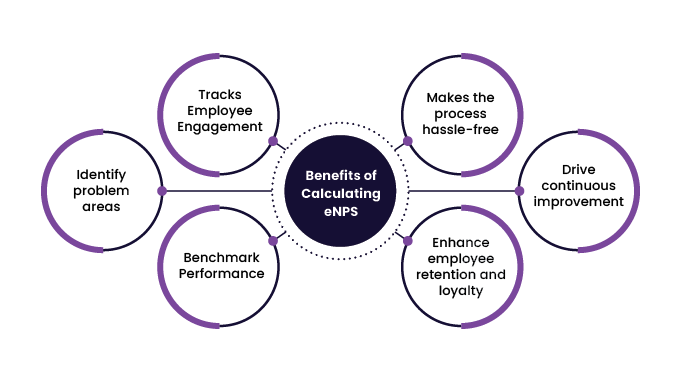
According to Forbes, the beauty of eNPS lies in its simplicity, which increases the likelihood of your employees’ participation.
Calculating the score can benefit your organization in numerous ways. Let us explore them in the section below:
Tracks Employee Engagement
eNPS provides a simple, effective, and standardized way of keeping track of employee engagement over time. Regular calculation of the score can help organizations keep a check on employee sentiments, identify trends, and gauge the effectiveness of their engagement initiatives.
Identifies Problem Areas
eNPS surveys help organizations to figure out specific areas where satisfaction levels are lacking. By analyzing feedback from detractors and passives, companies can identify and address the root causes of dissatisfaction through targeted actions.
Benchmark Performance
You can utilize the full potential of eNPS to benchmark performance. This will allow you to compare your organization’s eNPS with industry benchmarks and competitors’ scores. This, in turn, will help you understand where you stand in terms of employee satisfaction compared to your competitors. The comparison will help you in the following manner:
- Highlight your areas of strengths and areas that need improvement.
- Acts as a guide for goal setting and prioritizing initiatives for enhancing employee experience.
- Allows tracking your progress and evaluating the effectiveness of strategies
- Suggests improvements that make you attain a competitive edge in talent retention.
Makes the Process Hassle-Free
The process of calculating eNPS is simple in approach. The compactness and ease of calculation prevent survey fatigue. This also helps to conduct the survey at regular intervals.
Drives Continuous Improvement
Regular calculation of eNPS and acting on feedback received facilitates organizations to cultivate a culture of continuous improvement. Employees will likely feel valued and engaged when they see their feedback taken sincerely and acted upon.
Enhance Employee Retention and Loyalty
Higher eNPS is directly proportional to increased employee satisfaction levels, retention rates, and loyalty. A higher score implies that there are more promoters who are satisfied employees who are willing to show commitment. By improving employee satisfaction and engagement, organizations can witness a reduction in turnover costs and build a more loyal and committed workforce.
Although we have discussed the benefits, we cannot deny the fact that it has its set of limitations. They are as follows:
- eNPS alone may not be able to provide enough actionable insights to drive meaningful change. Organizations may instead need to supplement eNPS with other metrics to influence employee satisfaction.
- Employee responses towards the eNPS surveys can be biased in nature. They can be influenced by various factors like timing, survey fatigue, or social desirability bias, which could affect the results’ accuracy.
- The score only tells you the “what” but not the “why” and “how” of responses. Basically, employers only get a surface-level glance at employee sentiment but do not provide the context or reason behind what impacts the sentiment.
Irrespective of the limitations, you can try to overcome them by pairing eNPS with other complementary metrics, as mentioned in one of the pointers above:
Employee Satisfaction Surveys: These surveys focus on the specific aspects of employee experience that shed detailed insights into the areas of strength and weakness.
Employee Engagement Surveys: These surveys gauge employees' emotional connection and commitment toward their organization. They provide insights into factors that drive motivation and performance.
Employee Turnover Rate: This helps organizations understand their retention challenges and point out areas where they can make improvements to reduce turnover.
Performance Metrics: The metrics that encompass productivity, goal achievement, and overall performance offer additional insights into the impact of employee engagement and satisfaction on organizational outcomes.
Are you wondering how to get started with the surveys? Well, there are a range of tools to choose from, such as Vantage Pulse, Tinypulse, Culture Amp, Empuls, etc.
7 Tips on How to Improve eNPS
Improving eNPS would require you to follow a strategic approach that focuses on addressing those underlying factors that directly impact or influence employee satisfaction and engagement levels. The tips are as follows:
1. Focus on Asking Simple Questions
The more difficult the question, the more likely it will be misunderstood, misread, or skipped entirely.
The general rule of thumb is that if the question asks two separate questions, it is advisable to break it into two. Also, as much as possible, use straightforward and simple language.
Here are some examples of questions that you should consider avoiding in eNPS surveys:
On a scale of 1 to 10, how satisfied are you with the level of support and recognition you receive from your manager and the support you receive from your peers?
On a scale of 1 to 10, to what extent do you endorse that the organization embodies an optimal degree of professional proficiency in its operations?
The clarity of your eNPS survey questions directly affects the quality of the feedback you receive.
2. Conduct Regular Employee Feedback Surveys
To understand a company's culture, listen to its employees' stories.
– John Coleman, author and business expert
Regular employee feedback surveys are always suitable for gauging employee engagement and satisfaction levels. Surveys help HR professionals identify those areas that require attention and improvement around issues like communication, leadership, or work culture.
3. Continuous Improvement Through Tracking and Measuring eNPS Score
Rather than approaching eNPS as a one-time fix, leaders must quantitatively track and assess their rankings on a regular basis. Ensure frequent and consistent monitoring of eNPS and other relevant metrics by keeping track of progress. It will help you determine whether or not your action plans yield any positive outcomes.
Internal benchmarking is another great way to get the most out of your eNPS survey. By comparing your current results to those from previous surveys, you can track your progress and identify areas where improvements have been made, as well as areas that may need additional attention. Not only that, but you can also compare your eNPS scores to industry benchmarks to see how your organization stacks up against others in your field. This will give you valuable insights and help you make informed decisions on improving your workplace culture and employee experience.
Organizations must recognize the necessity for more efficient, real-time feedback mechanisms like pulse surveys, which offer a continuous, dynamic process rather than a static, one-time event.
4. Act on Survey Results
Simply conducting surveys, measuring, tracking, and evaluating them will not be enough. It's crucial to proactively respond to employee feedback by effectively implementing actionable measures that address their needs and requests.
5. Foster a Positive Workplace Culture
A positive workplace culture is central to sustaining employee satisfaction and engagement levels. HR professionals can undertake several measures to create a positive culture by communicating positive messages, recognizing employee achievements, celebrating milestones, promoting work-life balance, and offering wellness programs. Happy and engaged employees are more inclined to recommend your organization as a suitable workplace.
6. Communicate Effectively
Effective communication has always stood out in favor of organizations. It has contributed to keeping employees satisfied and committed. HR teams should be open and transparent about company updates or policy changes. Regular and transparent communication bridges the gap between management and employees and will make them feel connected as they develop inclusivity in important events and decisions.
7. Invest in Employee Training and Development
Employees always wish to work for organizations that offer them opportunities for career growth and development. Hence, HR professionals should invest in employees’ training and development opportunities through sponsoring online courses and offering mentorship programs. Investing in employees’ learning and development helps boost engagement and job satisfaction levels, resulting in higher eNPS scores.
Conclusion
The detailed discussion above has got you clarified on the significance of the Employee Net Promoter Score. The meaningful data or information derived from its calculation can be leveraged to build an employee-centred workplace.
Your journey to creating a thriving workplace for employees begins now. Use eNPS as your powerful ally and enhance employees’ experience, engagement, and satisfaction levels.










